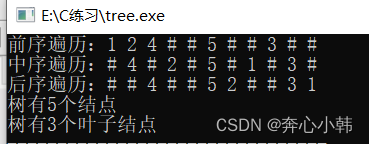Overview:
Binary tree uses the child linked list storage method, that is, one data field and two left and right child pointer fields. Then just traverse recursively. When creating a binary tree, first create each binary tree node (the nodes here are dynamically allocated, so the nodes are pointer variables), and then, according to the logical structure diagram, manually link to the corresponding location through the left and right pointer fields.
code show as below:
#include <stdio.h>
#include <string.h>
#include <stdlib.h>
//二叉树结点
typedef struct BTnode
{
int data;
struct BTnode *lchild,*rchild;
}BTnode;
BTnode* BuyNode(int x)
{
//创建树的结点空间,动态分配。
BTnode* node =(BTnode*)malloc(sizeof(BTnode));
//给结点赋值,指针域置空
node->data=x;
node->lchild=NULL;
node->rchild=NULL;
return node;
}
//创建二叉树
BTnode* CreatTree()
{
//创建树的结点
BTnode* node1 =BuyNode(1);//因为BuyNode是动态分配的空间,因此用指针接收
BTnode* node2 =BuyNode(2);
BTnode* node3 =BuyNode(3);
BTnode* node4 =BuyNode(4);
BTnode* node5 =BuyNode(5);
//手动链接起来。
node1->lchild=node2;
node1->rchild=node3;
node2->lchild=node4;
node2->rchild=node5;
//链接完毕,返回头指针,即根结点
return node1;
}
//打印树-前序遍历
void PreOrder(BTnode* root)
{
if(root == NULL)
{
printf("# ");
return;//返回调用的上一级
}
printf("%d ",root->data);
PreOrder(root->lchild);
PreOrder(root->rchild);
}
void InOrder(BTnode* root)//中序遍历
{
if(root == NULL)
{
printf("# ");
return;//返回调用的上一级
}
InOrder(root->lchild); //左
printf("%d ",root->data);//根
InOrder(root->rchild);//右
}
void PostOrder(BTnode* root)//后序遍历
{
if(root == NULL)
{
printf("# ");
return;//返回调用的上一级
}
PostOrder(root->lchild);//左
PostOrder(root->rchild);// 右
printf("%d ",root->data);//根
}
//计算树的结点,分治思想,分工,最后汇总。
int BTtreeSize(BTnode* root)
{
if(root ==NULL)//树是空的,就返回0
return 0;
else//不是空的,就进行左右子树遍历再加1,因为要给本身加上。空根不加一,但这里非空,必定+1;
{
//递归到叶子节点时,叶子节点的左右子树都为空,返回0,0+0+1=1,因此叶子节点再往上一层返回即可。
return BTtreeSize(root->lchild)+BTtreeSize(root->rchild)+1;
}
}
//计算树的叶子节点
int LeafSizes(BTnode* root)
{
//是空根就返回0
if(root ==NULL)
return 0;
//符合叶子结点特征,即结点的左右子树均为空,则返回1,即记录上
if(root->lchild ==NULL && root->rchild==NULL )
return 1;
else
//都不符合,便进入左右子树,进行递归计算,最后汇总即可。
return LeafSizes(root->lchild)+LeafSizes(root->rchild);
//实在不明白,画个递归图,就明白了。
}
int main()
{
BTnode* root=CreatTree();
//遍历递归打印时,每个结点调用结束,销毁空间,返回上一级调用位置。
//直到所有结点遍历结束,临时空间逐个销毁。
printf("前序遍历:");
PreOrder(root);
printf("\n中序遍历:");
InOrder(root);
printf("\n后序遍历:");
PostOrder(root);
//计算树的结点
int count=BTtreeSize(root);
printf("\n树有%d个结点",count);
int leafcount=LeafSizes(root);
printf("\n树有%d个叶子结点",leafcount);
return 0;
} result: